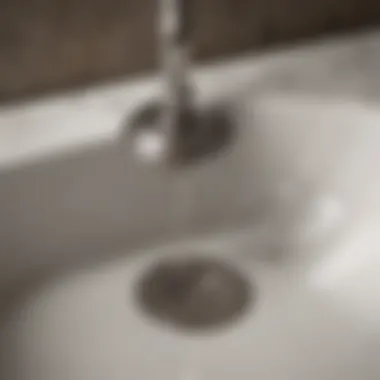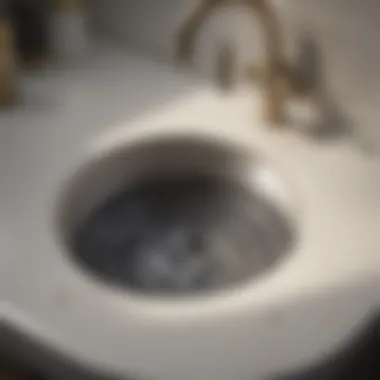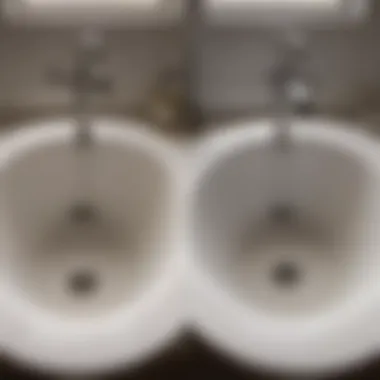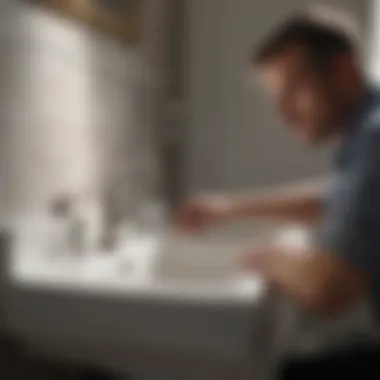Solving Common Bathroom Sink Drain Issues


Intro
Bathroom sink drains play a pivotal role in maintaining an efficient and pleasant environment in our homes. When they fail to function as expected, the entire atmosphere can be disrupted—leading to frustration and inconvenience. A sink that doesn’t drain well can turn a quick morning routine into a drawn-out affair as water accumulates and refuses to disappear.
Understanding the ins and outs of sink drainage systems is crucial for homeowners and renters alike. This knowledge not only helps in diagnosing issues effectively but also empowers individuals to take the necessary steps to remedy the problem. This article aims to provide a well-rounded exploration of what causes bathroom sink drains to malfunction, offer diagnostic steps, and outline practical solutions. Let’s dive into the various aspects that contribute to this common household issue.
Common Causes of Drain Issues
It’s essential to grasp the typical culprits behind a slow or stalled sink drain. Many factors contribute to this problem, making it imperative to identify the specific issue you're dealing with. Here’s a breakdown:
- Hair Buildup: One of the leading causes of clogs is hair. It doesn’t take much before strands start gathering, forming a stubborn mass that obstructs water flow.
- Soap Scum: Over time, soap residue can accumulate in the pipes, particularly if you’re using bars of soap. This sticky material can combine with hair and other debris, further complicating drain issues.
- Foreign Objects: Sometimes, items accidentally fall into the sink, leading to a blockage. A rogue toothbrush, a makeup cap, or even food particles can disrupt the flow.
- Pipe Design Flaws: Occasionally, the configuration of pipes may create natural blockages. Pipes that are too narrow or angled sharply can lead to water drainage problems.
Diagnostics
Before you rush to implement a solution, it's wise to conduct a thorough diagnosis. Here are a few methods to help pinpoint the issue:
- Visual Inspection: Start by peeking under your sink. Look for visible signs of leaks or loose connections.
- Plunger Test: Utilizing a plunger can sometimes dislodge minor clogs. Make sure to create a tight seal to maximize effectiveness.
- Drain Snake: This tool can help navigate through the pipes to extract stubborn clogs that are out of reach.
- Water Flow Check: Observe how water drains under varying conditions—sometimes running hot water can help dissolve build-ups.
"A little knowledge goes a long way. Understanding your sink's plumbing can save you from headaches down the road."
Practical Solutions
When you’ve identified the culprits behind your sink drain problem, it's time to explore possible remedies:
- DIY Methods: Start with simple fixes. A concoction of baking soda and vinegar can help dissolve minor blockages. Pour half a cup of baking soda down the drain, follow it with half a cup of vinegar, and let it sit for about fifteen minutes before flushing with hot water.
- Clearing Obstructions: If hair is the primary culprit, consider using a drain strainer to prevent future clogs. Additionally, employing a drain snake or a mechanical auger can reach deeper blockages.
- Calling a Professional: If your attempts don’t yield results, it might be time to consult a plumber. They can provide insights and tools that are otherwise unavailable.
Maintenance Tips
Prevention is always better than a cure. Regular maintenance can greatly reduce the likelihood of drainage issues:
- Routine Cleanouts: Periodically clean the drain traps and pipes to prevent buildup.
- Avoid Flushing Non-Biodegradable Items: Be mindful of what goes down the drain; it’s easy to dismiss a small item, but it can create significant issues.
- Use Drain Guards: Implementing a guard can catch hair and debris before they enter the plumbing system.
Understanding how to troubleshoot and maintain your sink can bring back the fluidity to your daily rituals. By adopting these practices, you will not only solve current issues but also proactively mitigate future problems.
Prolusion to Bathroom Sink Drain Issues
Bathroom sink drains are often an afterthought in home maintenance. However, when they start acting up, the inconvenience can rain on anyone's parade. A drain that won’t function as intended not only hampers daily routines but can also lead to other, more serious plumbing issues if left unaddressed.
Understanding the nuances of your bathroom sink drainage system is crucial for anyone who aims to keep their home running smoothly. From minor clogs caused by simple gunk build-up to more significant problems rooted in the plumbing itself, awareness of how these issues arise and how to tackle them is imperative. It can save time and heaps of frustration in the long run.
One key aspect to consider is the frequency of usage within bathrooms.
- High Traffic Areas: Bathrooms are typically some of the busiest spaces in a household. High usage increases the chances of potential blockages due to hair, soap residue, and other debris.
- Understanding Impact: A well-functioning sink promotes hygiene and comfort. When issues arise, it can create unsightly messes and unpleasant odors, making for a less welcoming environment.
- Home Value: Properly maintained plumbing not only enhances livability but can also play a role in the overall value of a home. Buyers can be wary of properties with unresolved plumbing issues.
"A stitch in time saves nine." Proactively addressing minor drain issues before they amplify often leads to less costly repairs or replacements down the line.
In this article, we will peel back the layers on diverse possible causes for sink drain failures. We’ll also delve into effective diagnostic steps and solutions that empower homeowners and renters alike to take control of their bathroom’s drainage needs. This educational journey not only enhances your knowledge but helps ensure a serene bathroom environment. Embracing preventative measures can ward off headaches that arise from neglecting seemingly minor issues.
Understanding Drain Mechanisms
When discussing bathroom sink drain issues, it’s crucial to understand the mechanisms at play. Knowing how drains function can significantly aid in diagnosing problems and determining the best solutions. This section can empower homeowners or renters causing them to approach the problem with confidence rather than frustration.
Gravity and Siphon Principles
At the heart of every drain system are the principles of gravity and siphoning. These forces work hand in hand to ensure that water flows away from your sink and towards the waste pipes. Simply put, gravity pulls the water downwards while the siphon effect helps to clear the water by creating a low-pressure area behind it.
However, if there's a blockage or other issue, these principles can be undermined. The flow can be sluggish, or, in some cases, water can back up. It's essential to understand that no matter how modern or fancy the drain system might be, these principles will always govern its function.
Types of Drain Systems
There are various types of drain systems, each designed with specific functionalities and features. A glance into these systems reveals not only how they operate but also the compatibility with the bathroom design appealing dependent on homeowner preference.


Standard Drain System
The Standard Drain System is perhaps the most common setup found in many bathrooms. It typically involves a simple design that utilizes gravity to facilitate drainage. One of its standout characteristics is that the drain easily allows for the passage of various types of liquids—be it water from a quick hand wash or the remnants of a beauty routine.
What makes the Standard Drain System a favored choice is its straightforward installation and maintained efficiency. However, it does have its limitations. Without proper care, it’s likely to become a breeding ground for clogs due to hair and soap build-up, requiring regular cleaning to avoid issues.
Pop-Up Drain Mechanism
Next is the Pop-Up Drain Mechanism. This feature adds convenience by permitting an easy open and close function for the drain, typically controlled by a lever behind the faucet. This mechanism’s primary advantage lies in its accessibility. You can control the water flow effortlessly, making it beneficial for those who frequently wash their hands or use the sink for lengthy tasks.
On the downside, this mechanism can be tricky to clean since the pop-up assembly has more parts than standard drains, which can be challenging to reach. Homeowners should be mindful of debris accumulation within this mechanism, as it can affect its operation.
Overflow Drain Features
Finally, let's discuss Overflow Drain Features. These are designed as a safety measure to prevent water from spilling over the edge of the sink. Positioned at a specific height, these overflow features allow excess water a place to escape, safeguarding your bathroom floor from unwanted puddles.
This function is a significant asset, especially in households with children or in scenarios where the sink might inadvertently be left running. Yet, it's not without drawbacks—if the overflow itself becomes obstructed, it can lead to backflow issues, causing water to stagnate and potentially create unpleasant odors.
Understanding these drain mechanisms lays the groundwork for tackling bathroom sink issues proactively. By knowing what to expect from your sink’s drainage system, you can better diagnose problems and consider effective solutions before they escalate.
Common Reasons for Drain Blockage
Understanding the common reasons behind drain blockages is crucial for both homeowners and renters alike. It's like knowing the enemy before going into battle. With the knowledge of what typically causes drain issues, you can take proactive steps to minimize the risk and handle potential problems before they escalate. The synergy between effective diagnostics and informed actions forms the backbone of maintaining a smoothly functioning bathroom sink. This section unpacks the familiar woes that lead to a sluggish or completely blocked drain, thereby equipping you with the insights needed to tackle these issues head-on.
Accumulation of Debris
Most often, when we talk about blocked drains, the conversation turns to debris—what’s in there that shouldn’t be? Every day, a multitude of substances makes their way down the drain, and these common culprits can create significant headaches.
Hairs
Hairs, whether long or short, are notorious for contributing to drain blockages. It’s intriguing to consider how something so fine can weave itself into a tangled mess. As hairs travel down the sink, they can grab hold of soap scraps or other debris, forming a larger blockage. One of the key characteristics of hairs is their tendency to clump together due to moisture. Often, these clumps can act like a filter, catching more debris along the way. This is why addressing hair accumulation is a must for preventing future troubles.
Soaps and Products
Then we have soaps and various products that get washed down. Many people don’t give much thought about how soap can solidify and build up over time. It's noteworthy how everyday shampoos and conditioners, especially those packed with thicker formulations, might leave residues that coat the insides of pipes. The significant aspect of soaps is their tendency to emulsify with grease and oils, turning into a thick paste that can lead to clogs in your drain. While they feel luxurious when applied, they can certainly become the bane of a sink’s existence.
Other Solids
Through daily use, sinks can also see a host of other solids washing away, be it food particles from brushing teeth (like bits of toothpaste or mouthwash) or other composite materials from beauty products. These various solids can collect over time and create a blockage. What characterizes these other solids is their unpredictable nature; you may not expect them to accumulate. Left unchecked, they can lead to fully blocked pipes, causing water to pool and backups that are not just inconvenient, but also unsightly.
Pipe Misalignments
Sometimes, the age of a home or hastily completed repairs can lead to misalignments in the plumbing. If the pipes don’t fit snugly together, it can create a perfect environment for debris to catch and build up. This is particularly common in older homes where wear and tear play a role or in situations where renovations haven't been completed correctly. The misalignment could cause a bend or kink in the pipe, which might not seem severe but can quickly lead to reduced water flow. Homeowners should be mindful of their plumbing layout; even a slight misalignment can spark bigger issues down the line.
Issues with the P-Trap
Clogs
When it comes to sink complications, clogs that originate from the P-trap are notorious. The P-trap is designed to catch debris, but this feature can backfire. It can hold build-up over time, which leads to significant slowdowns or complete blockages. One critical thing to remember is that the P-trap is easy to access and clean, making it a prime area for DIY attempts at unclogging. Keeping an eye on this section can prevent future headaches and loss of flow.
Leaks or Damage
Another facet to consider with the P-trap is the potential for leaks or damage. Though this may not be the first thought when considering drain problems, small leaks can lead to larger problems, like mold issues or structural damage in the long run. Identifying any cracks or signs of wear is essential, as a damaged section can cause continual drainage problems. Quick fixes may not hold if there’s underlying damage, so it’s best to tackle this promptly.
Ventilation Problems
Ventilation might seem a separate issue, but it’s intricately tied to how well your sink drains. Good ventilation is vital for allowing air to replace the air that water displaces in the pipes. Without proper ventilation, water might not flow as it should, leading to slow drainage. Look for signs of inadequate air supply in your plumbing system; if you notice that the water creates a gurgling noise or the sink seems to drain slowly, it could be pointing towards a ventilation issue. Fixing it may require consulting a professional, but being aware of it can save homeowners frustration later.
The knowledge of these factors enables you to act or react effectively when trouble arises. By knowing what to look out for, you stand a much better chance of keeping your bathroom sink functioning effectively.
Initial Diagnosis Steps


When faced with a bathroom sink drain that just doesn’t work as it should, taking a step back to assess the situation can save a lot of time and trouble. The initial diagnosis steps are critical. They not only help in pinpointing the specific issue but also guide you in deciding whether you can tackle the problem solo or if you need to call for reinforcements.
A thorough diagnosis acts like a roadmap. It prevents unnecessary trial and error, which can lead to frustration and additional costs. When you clearly understand what’s going on, you can employ the right methods to fix the problem and keep your sink, and by extension your entire bathroom, in good working order.
Visual Inspection
Before anything else, take a good, hard look at the situation. Visual inspection might sound simplistic, but it's often where a lot of problems can be identified quickly. Check for water pooling around the base of the sink or leaks under the cabinet. These signs often point to bigger issues lurking beneath the surface.
Look at the faucet and its connections too. Sometimes, the faucet itself can be the culprit, especially if there’s a sudden drop in water flow. If you see anything that looks out of place, jot it down before moving on.
Testing Flow Rate
Once you’ve visually inspected the area, it’s time to put your sink to the test. Checking the flow rate is a reliable method to see if something is amiss. Start by simply running the water and observe how well it drains. A noticeable decrease in water speed can indicate a blockage within the pipe or something more complex.
To get a bit more technical, you can time how long it takes for a certain amount of water to flow down the drain. If it takes significantly longer than usual, it might be a signal that you’ve got a blockage on your hands. This little test can really uncover hidden issues that wouldn’t be obvious at first glance.
Assessing the P-Trap
Nearing the end of your initial diagnosis are your P-Trap assessments. The P-Trap is the U-shaped pipe located beneath your sink. It plays a crucial role in preventing bad odors from entering your home while also catching debris from going further into your plumbing system.
Begin by examining the P-Trap for any visible clogs. If you see it filled with hair, soap scum, or any other material, you might have discovered the problem. Additionally, check for leaks or cracks. If your P-Trap is damaged, even the best of plumbing knowledge won’t help you if it’s not holding water.
If you can’t see anything wrong, you might consider unscrewing the trap for a more in-depth check. Just be prepared for a bit of water spillage and have a bucket handy!
"The more you know about your plumbing, the better you can care for it."
Each of these steps can significantly aid in determining why your bathroom sink drain is acting up. By taking the time to run through these diagnosis steps, not only do you arm yourself with valuable knowledge, but you also set the stage for finding an effective solution to the problem.
Effective DIY Solutions
When it comes to a bathroom sink drain that refuses to cooperate, addressing the issue yourself can be gratifying. This section will navigate through practical DIY solutions that savvy homeowners and housewives can implement, potentially saving time and cash that would otherwise go to professional services. Ignoring the problem for too long can lead to bigger headaches down the road; hence, understanding how to approach these fixes is invaluable. Knowing what tools and techniques are at your disposal can turn a perplexing situation into a manageable task.
Using a Plunger
One of the simplest yet effective tools you can have in your household arsenal is the plunger. When you think of a plunger, you might picture a toilet, but it’s equally beneficial for sinks suffering from sluggish drainage. To start, make sure you have a good quality plunger—preferably one designed for sinks rather than toilets.
Follow these steps:
- Seal the overflow drain (if applicable), using a wet cloth or tape to block it. This will create a vacuum and enhance suction.
- Align the plunger over the drain, ensuring there’s plenty of water covering the rubber cup.
- Push and pull vigorously for about 15-20 seconds, making a good seal with your plunger. The motion should be quick and forceful.
- Afterward, check if the water drains smoothly.
"A plunger is more than just a simple tool; it’s your first line of defense against stubborn clogs."
Baking Soda and Vinegar
If you’re looking for an eco-friendly solution, baking soda and vinegar can work wonders. This potent duo is not only effective but also perfect for those who wish to avoid harsh chemicals. The natural reaction between the two ingredients helps break down clogs. To execute this method:
- Pour a half-cup of baking soda directly into the drain.
- Follow it with a half-cup of white vinegar. This combination will fizz and bubble, helping to dislodge debris in its path.
- Let it sit for about 30 minutes to allow it to penetrate the blockage.
- Finally, flush the drain with hot water to wash away any loosened grime.
Regular use of this method can not only clear minor clogs but also maintain a fresh scent in your sink.
Manual Removal of Clogs
Sometimes, the trusty tools and household products just don’t cut it, which is when a more hands-on approach comes into play. Manual removal can seem daunting, but with the right preparations, it’s easily manageable. Here’s what you should do:
- Before you dive in, make sure you have a bucket, pliers, and a gloves to keep things clean.
- Start by using the bucket to catch any water or debris when you remove the P-trap. This is usually located beneath the sink, shaped like a U.
- Loosen the fittings with your pliers, carefully detach it, and inspect for clogs within the trap itself. Many times, hair and soap residue accumulate here.
- Clean the trap thoroughly, removing any gunk that’s settled inside. Once done, reattach it, ensuring all seals are tight to prevent leaks.
By undertaking this method, you not only resolve your current problem but will also extend the life of your sink's plumbing by keeping components clean.
Each of these DIY solutions not only empowers you to tackle immediate drainage issues but also fosters a preventative mindset for future maintenance. In the long run, being proactive can prove far more effective than waiting for problems to festuate.
When to Call a Professional


Experiencing issues with a bathroom sink drain can evoke a mix of frustration and confusion. While there are numerous DIY solutions to tackle common drainage problems, recognizing when to call in a professional plumber is crucial. Ignoring persistent issues may escalate the situation, leading to more complex and costly repairs.
Seeking assistance from a qualified expert is advisable when you find yourself in certain situations. Not every plumping issue is within the realm of a handy homeowner. To ensure the longevity of your plumbing system and avoid unnecessary damage, knowing when to hand off the reins can save you time, money, and heartache.
Identifying Persistent Problems
When the drain obstruction proves stubborn—or returns shortly after a DIY fix—it’s likely a sign that something deeper lies beneath the surface. Several symptoms indicate the problem may require expert intervention:
- Continued Slow Draining: If you’ve tried plunging, baking soda and vinegar, or even a manual cleaning of the trap but the drain continues to slow down, the issue might be a buildup further down the line.
- Recurring Clogs: Unusual clogs that repeatedly resurface signal that the drainage system could be mishandled. The issue may lie within the plumbing itself, demanding a professional's diagnosis.
- Foul Odors: Unpleasant smells coming from the sink—even when it appears to be draining fine—could be a sign of decay or blockage in the plumbing that needs expert eyes.
- Water Backflow: If you start seeing water backing up into your sink or any other part of the plumbing, that’s an immediate red flag. Backflow often indicates a serious blockage further down the line, which usually requires a pro’s touch.
"Sometimes what seems like a small issue can spiral into something more severe. Recognizing those warning signs early can save a lot of headaches later on."
Understanding Plumbing Depth
Plumbing isn’t merely a series of pipes; it’s an intricate network. Some clogs are reachable through basic DIY methods, but others lie deeper in the plumbing system, far beyond what a novice should attempt. Understanding the depth of the issue can be a game-changer in determining when to enlist professional help.
- Complex Drain Architecture: Modern plumbing often features intricate systems with multiple junctions and fixtures. A clog may develop at any point along this network, making it difficult to locate without specialized tools and knowledge.
- Deeper Blockages: Blockages that occur in the main sewer line or deeper sections of the plumbing often require powerful equipment such as commercial augers or hydro-jetting. These are not household tools, and mishandling them can cause significant damage.
- Damage Inspection: If you suspect that something more than a clog, such as a broken pipe or misalignment, might be the issue, a professional plumber has the training to conduct a thorough inspection. They can discern minor issues from significant ones, reducing the chance of future complications.
In short, knowing when to call a professional regarding your bathroom sink drain’s difficulties is vital. It allows for effective management of plumbing issues without risking additional complications down the line. Always keep an eye out for warning signs, and consider the complexity of the problem to make a well-informed decision.
Preventative Measures
Addressing the issue of ineffective bathroom sink drainage begins long before the first sign of trouble is evident. Preventative measures play a critical role in maintaining the functionality and longevity of your sink drainage system. When you take the time to implement thoughtful strategies, you not only mitigate the risk of clogs and blockages but also extend the lifespan of your plumbing. Keeping your sink in good shape avoids costly repairs and headaches down the line, which can be quite inconvenient.
One of the most effective ways to ensure smooth drainage is regular maintenance. This includes routine checks and cleaning practices. Establishing a consistent routine prevents minor problems from escalating into significant issues.
Another aspect to consider is choosing appropriate products to help maintain a clean and functional sink drainage system. The products you use can make a world of difference. Here are two key categories:
- Drain Guards
- Biodegradable Cleaners
Regular Maintenance
Regular maintenance is like a breath of fresh air for your sink. It’s that proactive approach to home care that makes all the difference. By simply checking your sink on a regular basis and performing basic cleaning chores, you can prevent many issues before they start.
- Visual Checks: Take a moment to look under the sink. Keeping an eye out for leaks or moisture can highlight small issues before they turn serious.
- Routine Cleaning: At least once a month, clear out the P-trap and check for any buildup. A simple vinegar rinse can work wonders.
- Educate Household Members: Make sure everyone in your home knows not to dispose of unsuitable items down the sink, like waste products and food particles.
Choosing Appropriate Products
Choosing the right products for maintenance is essential. While there are many options on the market, focusing on effective and environmentally friendly solutions is wise. Let’s take a closer look at drain guards and biodegradable cleaners.
Drain Guards
Drain guards serve as a protective barrier against debris entering your plumbing. Think of them as your sink’s first line of defense. The key characteristic of drain guards is their effectiveness in trapping hairs, soap residue, and other solids before they enter the pipes.
- Benefits: Using drain guards can save you time and money spent on future plumbing solutions. They are easy to use and clean, which makes them a popular choice.
- Unique Feature: Many drain guards can be easily removed for cleaning and can fit most standard sink sizes.
- Disadvantages: On the flip side, if not cleaned regularly, they can become clogged themselves. It’s a small price to pay for maintaining drainage efficiency, though.
Biodegradable Cleaners
Biodegradable cleaners provide a sustainable option for keeping your sink in tip-top shape. These products break down naturally and are safer for both the environment and your plumbing. A key feature of biodegradable cleaners is that they often contain natural ingredients, which makes them a gentle choice for regular use.
- Benefits: These cleaners help break down soap scum, grease, and other pesky deposits that can build up in your drain without harsh chemicals.
- Unique Feature: They are often formulated to promote a healthy microbiome in your plumbing, which contributes to ongoing drainage efficiency.
- Disadvantages: One thing to keep in mind is that they may require more frequent application compared to traditional chemical cleaners that provide immediate results.
By taking preventative measures and using effective products, homeowners can significantly reduce the instances of sink drain issues, maintaining a serene and efficient bathroom environment.
Utilizing these practices not only assists in preventing drainage issues but also promotes a positive home atmosphere, ensuring the bathroom remains a retreat rather than a source of frustration.
End and Future Considerations
In wrapping up the discussion around the workings of bathroom sink drains, it’s important to recognize both the immediate impacts of a malfunctioning drain and the long-term considerations that come into play. Having a properly functioning sink drain is not just about convenience; it significantly affects the overall hygiene and usability of your bathroom.
First and foremost, regular maintenance proves to be a cornerstone of effective drain care. It’s a simple yet often overlooked part of home upkeep. Making it a habit to clean the drain cover and check for debris can prevent a minor issue from spiraling into a major plumbing headache. Homeowners should take note of their habits as well—using excessive amounts of product can lead to buildup over time.
"A stitch in time saves nine." This old saying rings especially true when it comes to plumbing—a small, preventative measure can save a lot of trouble later.
Looking ahead, it’s wise to consider the types of products purchased for drain maintenance. Opting for biodegradable cleaners not only addresses clogs sustainably but also lessens potential damage to piping systems. Drain guards are another excellent investment. These simple, yet effective tools can catch hair and debris, reducing the need for frequent cleanings.
Moreover, understanding the anatomy of your sink drain system—such as how the P-trap functions—equips homeowners with the knowledge needed to tackle small problems before they swell into larger ones. Every little bit counts, and having a fingertip grasp of what goes on behind the scenes in your bathroom’s plumbing can lead to more confident maintenance.
It’s never too late to begin implementing some of these strategies to not just react to problems as they arise, but to anticipate and avoid them altogether. With proper knowledge and the right tools, addressing or preventing issues with bathroom sink drains can become a seamless part of your household routine.















